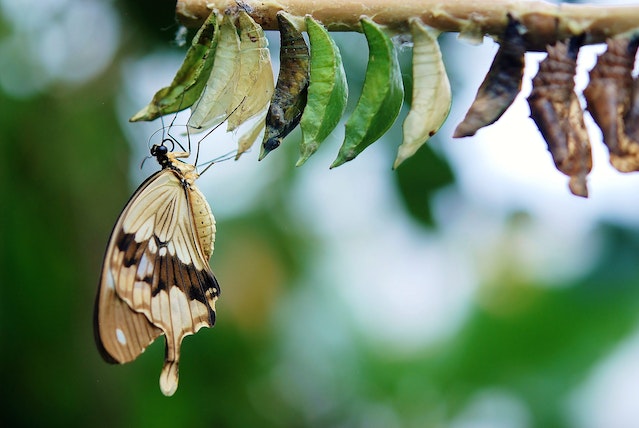
How does a caterpillar become a butterfly? By dissolving itself and regrowing.
Caterpillars start life as an egg. Female butterflies lay eggs on leaves. It varies by species, but a Monarch butterfly lays about 300 to 400 eggs over a two to five week period. Not all of these eggs will survive. Many of them will be eaten by ants, spiders, wasps, birds, and a whole host of other animals and insects. The butterflies lay the eggs at the bottom of the leaf in an effort to hide them. The butterflies secrete an adhesive-like substance that they use to stick the eggs to the leaf. The caterpillar will stay in the egg for about four to five days before hatching. Once they have hatched, they eat the egg to get enough energy to head for the leaf, which they start eating.
Once the caterpillar is out of the egg, it is called a larva. All insects that go through a metamorphosis have a growth phase, and they are called larvae. They stay in this stage for about two weeks and their job is to get bigger. They eat constantly and they grow constantly. Their skin doesn’t grow with them and each time they get too big for the skin, they shed it. The new skin underneath is soft, but it gets hard quite quickly. The caterpillar will usually eat the skin that it has shed because it needs all the calories it can get. They are known as “eating machines” and they grow very rapidly. Many caterpillars will increase in size by a hundred or more times in just a couple of weeks. They have evolved to grow very quickly because they are extremely vulnerable during their larval stage. Many animals prey on caterpillars and they are unable to escape. Some caterpillars have evolved toxins or detachable spines as a defense mechanism, but the safest defense is to become a butterfly as quickly as possible.
Caterpillars continue to eat until they are large enough to move onto the next stage in their lives: the pupa. The caterpillar spins a silk mat from a leaf and then hangs upside down from the mat. It sheds its skin for the last time and the new skin that emerges is the shell of the chrysalis. It is soft to start with, just like each time it sheds its skin, but it very quickly hardens.
How does a caterpillar know when it is time to pupate? Caterpillars produce two different types of hormone. One is called ecdysone and the other is called juvenile hormone. Inside the caterpillar are sacs of cells called imaginal dics. These cells are like stem cells, in that they can become any other type of cell. The hormone ecdysone is what makes the caterpillar molt its skin each time it gets too big, and the juvenile hormone suppresses the genes in the imaginal discs that tell the caterpillar to start metamorphizing. As the caterpillar gets larger, the amount of juvenile hormone decreases at an evolutionarily programmed rate. By the time the caterpillar is big enough, the juvenile hormone has decreased sufficiently that on the last molt, the ecdysone makes the caterpillar enter metamorphosis.
It is worth noting that a chrysalis and a cocoon are different. Butterflies metamorphize inside a shell of hardened skin, which is called a chrysalis. Moths often spin a case of silk that they cover their pupal stage with. This is called a cocoon.
So, how does a caterpillar become a butterfly? Once the caterpillar is big enough, the juvenile hormone drops and the genes in the imaginal discs are triggered. The caterpillar seals itself inside its chrysalis and it starts to digest itself. The cells in the caterpillar activate enzymes called caspases. Caspases can break down cellular structures, kill the cells, and release the proteins. This is the same process that happens in our bodies all the time. The caterpillar is digested down into the imaginal discs. The rest of the caterpillar becomes a rich, proteiny soup sealed inside the chrysalis. The imaginal discs start to grow new cells using the soup that was the caterpillar. They form the head, thorax, and all of the other parts.
The imaginal discs take one or two weeks and by the end, they have grown into the butterfly. Each imaginal disc is responsible for growing a different part of the butterfly and they all have locational information programmed into them. All of the parts join together and the butterfly is good to go. The fully grown butterfly secretes a liquid to soften the chrysalis and it emerges. They unfurl their wings and then wait to dry. It can be a few hours before the wings are dry enough and they are very delicate for all of this time. Once the wings have dried, the butterfly flies off.
So, how does a caterpillar become a butterfly? By digesting itself and then using the soup to make new cells that form parts of the butterfly. And this is what I learned today.
Sources
https://wisconsinpollinators.com/BU/BA_ButterflyChrysalis.aspx
https://www.sciencedirect.com/topics/chemistry/ecdysone
https://www.abc.net.au/science/articles/2011/12/07/3384014.htm
https://www.sciencedirect.com/topics/neuroscience/caspase
https://en.wikipedia.org/wiki/Caterpillar
https://monarchjointventure.org/monarch-biology/life-cycle/pupa
https://ansp.org/exhibits/online-exhibits/butterflies/lifecycle/
https://monarchjointventure.org/monarch-biology/life-cycle/larva
https://monarchjointventure.org/monarch-biology/life-cycle/egg
https://monarchjointventure.org/faq/how-many-eggs
https://www.cell.com/current-biology/pdf/S0960-9822(10)00291-5.pdf
